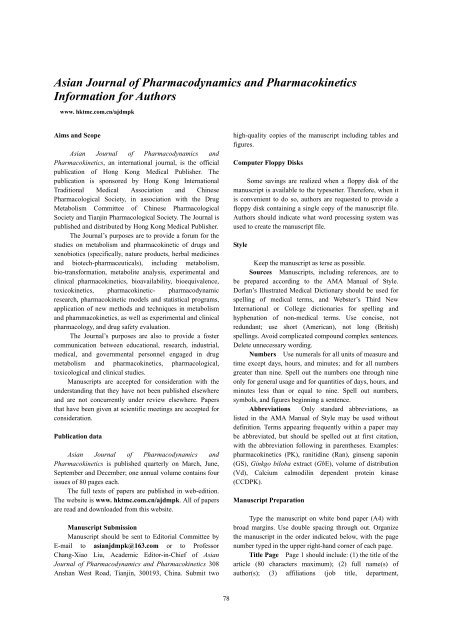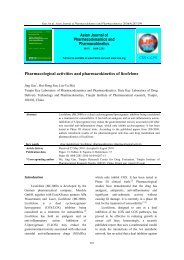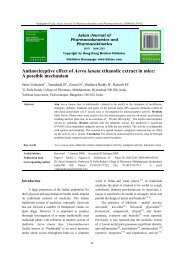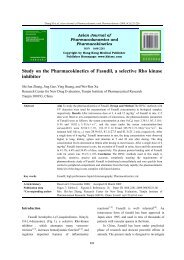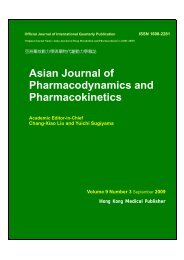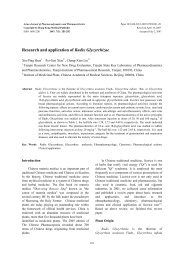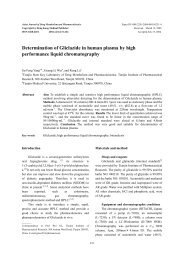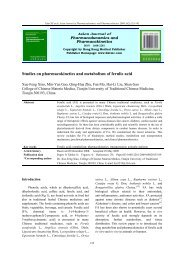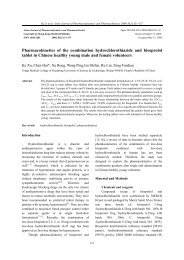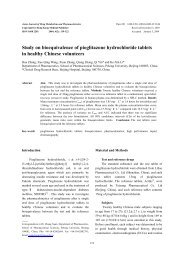Asian Journal of Pharmacodynamics and Pharmacokinetics ...
Asian Journal of Pharmacodynamics and Pharmacokinetics ...
Asian Journal of Pharmacodynamics and Pharmacokinetics ...
Create successful ePaper yourself
Turn your PDF publications into a flip-book with our unique Google optimized e-Paper software.
<strong>Asian</strong> <strong>Journal</strong> <strong>of</strong> <strong>Pharmacodynamics</strong> <strong>and</strong> <strong>Pharmacokinetics</strong>Information for Authorswww. hktmc.com.cn/ajdmpkAims <strong>and</strong> Scope<strong>Asian</strong> <strong>Journal</strong> <strong>of</strong> <strong>Pharmacodynamics</strong> <strong>and</strong><strong>Pharmacokinetics</strong>, an international journal, is the <strong>of</strong>ficialpublication <strong>of</strong> Hong Kong Medical Publisher. Thepublication is sponsored by Hong Kong InternationalTraditional Medical Association <strong>and</strong> ChinesePharmacological Society, in association with the DrugMetabolism Committee <strong>of</strong> Chinese PharmacologicalSociety <strong>and</strong> Tianjin Pharmacological Society. The <strong>Journal</strong> ispublished <strong>and</strong> distributed by Hong Kong Medical Publisher.The <strong>Journal</strong>’s purposes are to provide a forum for thestudies on metabolism <strong>and</strong> pharmacokinetic <strong>of</strong> drugs <strong>and</strong>xenobiotics (specifically, nature products, herbal medicines<strong>and</strong> biotech-pharmaceuticals), including metabolism,bio-transformation, metabolite analysis, experimental <strong>and</strong>clinical pharmacokinetics, bioavailability, bioequivalence,toxicokinetics, pharmacokinetic- pharmacodynamicresearch, pharmacokinetic models <strong>and</strong> statistical programs,application <strong>of</strong> new methods <strong>and</strong> techniques in metabolism<strong>and</strong> pharnmacokinetics, as well as experimental <strong>and</strong> clinicalpharmacology, <strong>and</strong> drug safety evaluation.The <strong>Journal</strong>’s purposes are also to provide a fostercommunication between educational, research, industrial,medical, <strong>and</strong> governmental personnel engaged in drugmetabolism <strong>and</strong> pharmacokinetics, pharmacological,toxicological <strong>and</strong> clinical studies.Manuscripts are accepted for consideration with theunderst<strong>and</strong>ing that they have not been published elsewhere<strong>and</strong> are not concurrently under review elsewhere. Papersthat have been given at scientific meetings are accepted forconsideration.Publication data<strong>Asian</strong> <strong>Journal</strong> <strong>of</strong> <strong>Pharmacodynamics</strong> <strong>and</strong><strong>Pharmacokinetics</strong> is published quarterly on March, June,September <strong>and</strong> December; one annual volume contains fourissues <strong>of</strong> 80 pages each.The full texts <strong>of</strong> papers are published in web-edition.The website is www. hktmc.com.cn/ajdmpk. All <strong>of</strong> papersare read <strong>and</strong> downloaded from this website.Manuscript SubmissionManuscript should be sent to Editorial Committee byE-mail to asianjdmpk@163.com or to Pr<strong>of</strong>essorChang-Xiao Liu, Academic Editor-in-Chief <strong>of</strong> <strong>Asian</strong><strong>Journal</strong> <strong>of</strong> <strong>Pharmacodynamics</strong> <strong>and</strong> <strong>Pharmacokinetics</strong> 308Anshan West Road, Tianjin, 300193, China. Submit twohigh-quality copies <strong>of</strong> the manuscript including tables <strong>and</strong>figures.Computer Floppy DisksSome savings are realized when a floppy disk <strong>of</strong> themanuscript is available to the typesetter. Therefore, when itis convenient to do so, authors are requested to provide afloppy disk containing a single copy <strong>of</strong> the manuscript file.Authors should indicate what word processing system wasused to create the manuscript file.StyleKeep the manuscript as terse as possible.Sources Manuscripts, including references, are tobe prepared according to the AMA Manual <strong>of</strong> Style.Dorlan’s Illustrated Medical Dictionary should be used forspelling <strong>of</strong> medical terms, <strong>and</strong> Webster’s Third NewInternational or College dictionaries for spelling <strong>and</strong>hyphenation <strong>of</strong> non-medical terms. Use concise, notredundant; use short (American), not long (British)spellings. Avoid complicated compound complex sentences.Delete unnecessary wording.Numbers Use numerals for all units <strong>of</strong> measure <strong>and</strong>time except days, hours, <strong>and</strong> minutes; <strong>and</strong> for all numbersgreater than nine. Spell out the numbers one through nineonly for general usage <strong>and</strong> for quantities <strong>of</strong> days, hours, <strong>and</strong>minutes less than or equal to nine. Spell out numbers,symbols, <strong>and</strong> figures beginning a sentence.Abbreviations Only st<strong>and</strong>ard abbreviations, aslisted in the AMA Manual <strong>of</strong> Style may be used withoutdefinition. Terms appearing frequently within a paper maybe abbreviated, but should be spelled out at first citation,with the abbreviation following in parentheses. Examples:pharmacokinetics (PK), ranitidine (Ran), ginseng saponin(GS), Ginkgo biloba extract (GbE), volume <strong>of</strong> distribution(Vd), Calcium calmodilin dependent protein kinase(CCDPK).Manuscript PreparationType the manuscript on white bond paper (A4) withbroad margins. Use double spacing through out. Organizethe manuscript in the order indicated below, with the pagenumber typed in the upper right-h<strong>and</strong> corner <strong>of</strong> each page.Title Page Page 1 should include: (1) the title <strong>of</strong> thearticle (80 characters maximum); (2) full name(s) <strong>of</strong>author(s); (3) affiliations (job title, department,78
institution,city, <strong>and</strong> state or country) indicating whichauthors are associated with which affiliations; <strong>and</strong> (4)Footnotes may include the name <strong>and</strong> address <strong>of</strong> the authorto whom reprint requests are to be sent, <strong>and</strong> correspondenceto which author, phone, Fax, <strong>and</strong> E-mail, as well as source<strong>of</strong> financial support..Abstract <strong>and</strong> Key Words Page 2 should includethe title <strong>of</strong> the article followed by the abstract, which shouldbe about 200 words. The abstract should summarize themain points <strong>of</strong> the article. The abstract in structured formconsists <strong>of</strong> Aim (the purpose <strong>of</strong> the study), Methods (basicproedures), Results (main findings with main data) <strong>and</strong>Conclusions. Following the abstract, list 4-8 key words forindexing.TextPapers should be organized in the following format:Introduction, Materials <strong>and</strong> methods, Results, discussion,<strong>and</strong> references.Introductionsummarizes the rationale <strong>and</strong> gives a concisebackground. Use references to provide the most salientbackground rather than an exhaustive review. The lastsentence should state tersely your purpose to do this study.An uncommon or new compound should be identified bythe chemical name <strong>and</strong> structural formula.Materials <strong>and</strong> methodsMaterials International Nonproprietary Names (INN)or generic names should be employed whenever possible. Ifnecessary, the proprietary name may be added once, inparentheses. The first letter <strong>of</strong> the drug name should besmall for INN or generic names, but capitalized forproprietary names. Manufacturers <strong>and</strong> specifications shouldbe given for main drugs, chemicals, <strong>and</strong> instruments. Thedrug administration schedule should be identified, includesdose <strong>and</strong> route <strong>of</strong> administration. Scientific name for allmicroorganism, plants, <strong>and</strong> animals should be given. Thesex, age, <strong>and</strong> actually measured body weights <strong>of</strong> testedanimals or humans should be expressed as mean, st<strong>and</strong>arddeviation, <strong>and</strong> total range.Methods: Offer technical information to allow theexperiments to be repeated. Describe new methods ormodifications <strong>and</strong> identify the unusual instruments <strong>and</strong>procedures in sufficient detail. The routes <strong>of</strong> administrationmay be abbreviated, eg, intraarterial (ia),intracerebroventricular (icv), intragastric gavage (ig),intramuscular (im), intraperitoneal (ip), intravenous (iv), peros (po), subcutaneous (sc). Dosage is expressed as per kg( in animals).Statistical Methods: Statistical methods should bedescribed to verify the results. Give number <strong>of</strong> observations<strong>and</strong> subjects. Report losses to observations, such asdropouts from the study. Only homogeneous data can beaveraged. The st<strong>and</strong>ard deviation (s) is much preferred tost<strong>and</strong>ard error (s x ).Suitable techniques should be chosen for the statisticaltreatments, eg, t test (group or paired comparisons),chi-squqre test, Ridit, probit, logit, regression, correlation,analysis <strong>of</strong> variance (ANOVA), analysis <strong>of</strong> covariance, etc.Effective digits are determined by the precision <strong>of</strong> themeasuring instruments. Do not include more digits than arejustified by the accuracy <strong>of</strong> the determinations.ResultsSimple data may be set forth in text with no need <strong>of</strong>tables or figures. Described results should beunderst<strong>and</strong>able <strong>and</strong> clear. The word “significantly” shouldbe replaced by its synonyms, if it indicates, or the p value, ifit indicates statistical significance. The tables <strong>and</strong> figuresshould be prepared according to following principles.Summarize or emphasize the results followed by tables orfigures. Reserve extensive interpretations <strong>of</strong> the results forthe discussion section.Tables: Each table should have a brief title. Type eachtable on separate sheet. If the table must exceed one page,duplicate all headings on the second sheet. Number tablesin the order in which they are cited in the text. Define allabbreviations <strong>and</strong> indicate the units <strong>of</strong> measurement for allvalues. Explain all empty spaces or dashes. If data from anyother source, published or unpublished, are used, obtain apermission letter for their use <strong>and</strong> cite the source in thelegend.Figures: Figures should be pr<strong>of</strong>essionally drawn inblack ink <strong>and</strong>, if possible, submitted as glossy, high-contrastblack-<strong>and</strong>-white photographs between three <strong>and</strong> six inchesin width. Letters, numbers, <strong>and</strong> symbols should be clearthroughout, <strong>and</strong> should be large enough to remain legiblewhen reduced for publication. In general, the size is height:width = 2;3. Be sure that all spelling is correct, that thereare no broken letters or uneven type, <strong>and</strong> that abbreviationsused are consistent with those in the text. The data fordrawing the figures should be typed on separate sheets <strong>and</strong>submitted along with the figures.Quantity <strong>and</strong> unit: Physical quantity is printed initalic type. A subscript that represents a symbol for aphysical quantity is printed in italic type. A solidus (/) shallnot be followed by a multiplication sign or a division signunless parentheses are inserted to avoid any ambiguity. Incomplicated cases negative powers or parentheses shall beused. SI units must be used.DiscussionDiscussion should deal with interpretations <strong>of</strong> yourresults. Emphasize any new <strong>and</strong> important aspects <strong>and</strong>relate your results to other studies. Discuss theshortcomings in your experiments. New hypotheses <strong>and</strong>recommendations may be proposed when warranted.End with a brief conclusion, which ought to be linked withthe goal stated in introduction.AcknowledgmentsAcknowledgments may briefly include (1) contributorsthat do not warrant authorship; (2) technical help; <strong>and</strong> (3)financial or material support.ReferencesType references double-spaced <strong>and</strong> number themconsecutively in the order in which they are first mentionedin text, not alphabetically. The references should conform to79
the style recommended in the AMA Manual <strong>of</strong> Style.References in text, tables, <strong>and</strong> legends are identified byArabic numerals typed parenthetically.Authors are responsible for the accuracy <strong>and</strong>completeness <strong>of</strong> the references.For journal articles, include: (1) author name(s) <strong>of</strong> allauthors; (2) title; (3) journal title abbreviated as it appearsin the Index Medicus or spelled out if it is not listed; (4)year <strong>of</strong> publication; (5) volume number; (6) issue; <strong>and</strong> (7)inclusive page numbers.For books, list: (1) author name(s); (2) title, includingnumber <strong>of</strong> editions; (3) chapter title if appropriate; (4)editor; (5) place <strong>of</strong> publication, publisher, <strong>and</strong> yearpublished; (6) volume number <strong>and</strong> (7) page numbers ifappropriate.For Conference proceedings <strong>and</strong> conference papers,list: (1) author name(s) <strong>of</strong> all authors; (2) title; (3) Name <strong>of</strong>Conference proceedings or Conference Paper Collection; (4)year, month, data, place (Country, city); (5) place <strong>of</strong>publication, publisher, <strong>and</strong> year published; (6) volumenumber <strong>and</strong> (7) inclusive page numbers.Unpublished observations <strong>and</strong> personalcommunications should not appear in the references.Manuscripts that have been accepted for publication buthave not yet been published may appear in the references:include authors, manuscript title, <strong>and</strong> name <strong>of</strong> journalfollowed by “in press” in parentheses.Sample references1. Abraham BK, Adithan C, Usha Kiran P, Asad M,Koumaravelou K. Genetic polymorphism <strong>of</strong> CYP2D6 inkamataka <strong>and</strong> <strong>and</strong>hra pradesh population in india. ActaPharmacol Sin 2000; 21: 494-8.2. Liu CX. Studies on Drug Metabolism <strong>and</strong>pharmacokinetics in China. ISSX Newsletter 1990; 9(2):1-2.3. Milton AS. Prostagl<strong>and</strong>ins <strong>and</strong> fever. In: Sharma HS,Westman J, editors. Progress in brain research; v 115.Brain function in hot environment. Amsterdam: Elsevier;1998; 129-39.4. Wnag LCK. Current drug safety testing in USA.Proccedings <strong>of</strong> International Symposium on TraditionalMedicines <strong>and</strong> Modren Pharmacology; 1987 May 2-4;Beijing, China. Beijing: Chinese PharmacologicalSociety; 1987; 257-61.5. World Health Organization. Good manufacturingpractices for pharmaceutical products. Annex 1.Thirty-second Report <strong>of</strong> the WHO Expert Committee onSpecifications for pharmaceutical preparation. WHOTechnical Report Series N.823. Geneva, Switzerl<strong>and</strong>:World Health Organization.6. Guo FK, Li YL, Wu SG. Antisense IRAK-2oligonucleotide inhibits interleukin-1-induced nuclearfactor-kB activiation in vitro. Acta Pharmacol Sin 2000;21: in press.Editor’s NoteThe instruction for manuscript preparation assumecertain resources are available to the author. Althoughcompliance with these instructions will increase theprobability <strong>of</strong> publication in the <strong>Journal</strong>, authors should notbe discouraged in submitting manuscripts that do notcompletely comply with these instructions. If an authorfeels his/her manuscript is worthy <strong>of</strong> publication in the<strong>Journal</strong>, he/she should do as much as possible to comply,then submit it to the editor. If the editor <strong>and</strong> editorial boardagree on its desirability for publication, the Editorial Officewill assist in satisfying the publisher’s manuscriptpreparation requirements.Review <strong>and</strong> Publication ProcessManuscripts are examined by the Editor <strong>and</strong> in mostcases by reviewers. Decisions <strong>of</strong> the Editor are final. Allmaterial accepted for publication is subject to copyediting.Authors will receive page pro<strong>of</strong>s before publication, <strong>and</strong>should answer all queries <strong>and</strong> carefully check all editorialchanges at this point.The first author <strong>of</strong> each article will freely receive 4copies <strong>of</strong> the complete issue.Copyright ProtectionThe submission <strong>of</strong> the manuscript by author meansthat the authors automatically agree to assign exclusivecopyright to Hong Kong Medical Publisher once thismanuscript is accepted for publication. The work should notbe published elsewhere in any forms without writtenpermission <strong>of</strong> the Publisher. The paper published in HongKong Medical Publisher is protected by copyright, whichcovers the translation rights <strong>and</strong> exclusive right toreproduce <strong>and</strong> distribute all <strong>of</strong> the articles published inHong Kong Medical Publisher.80


